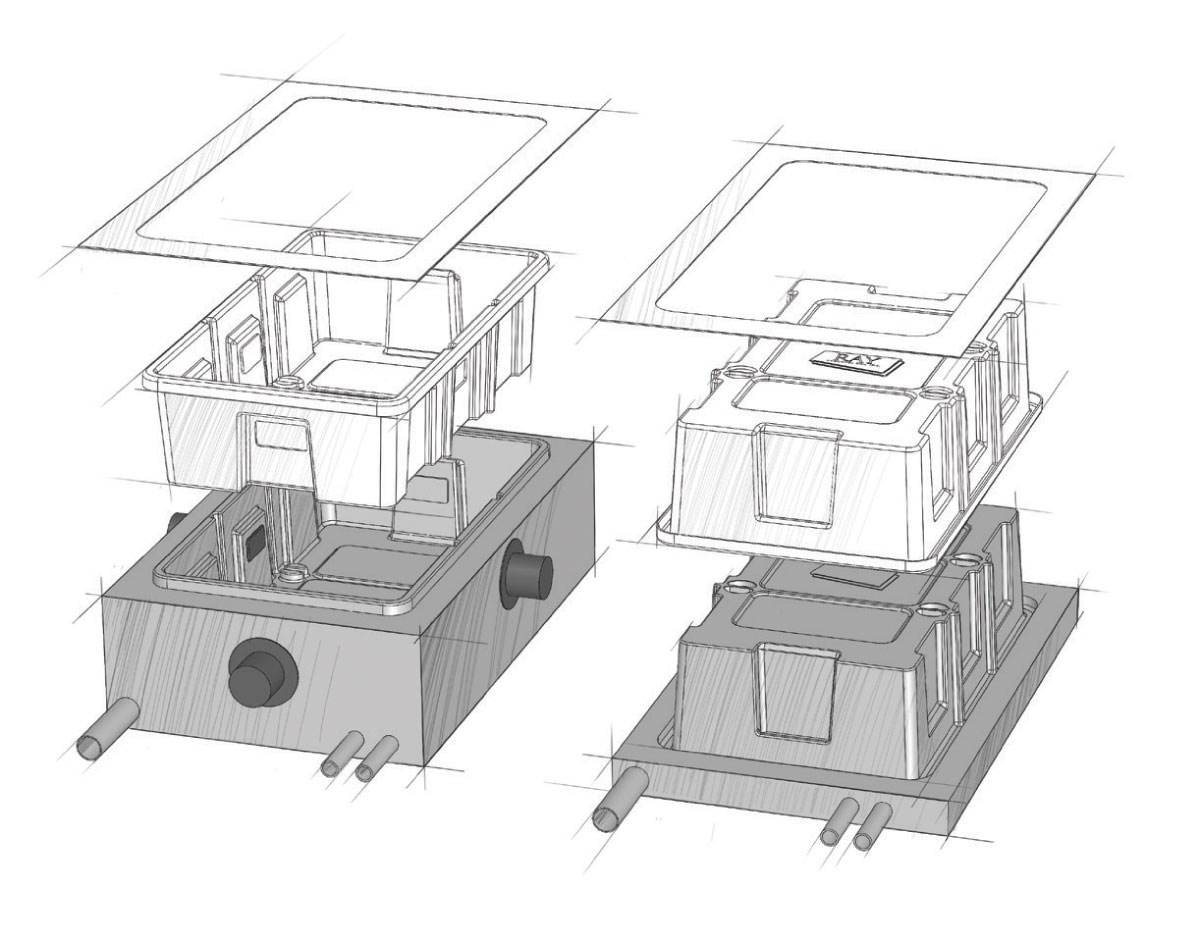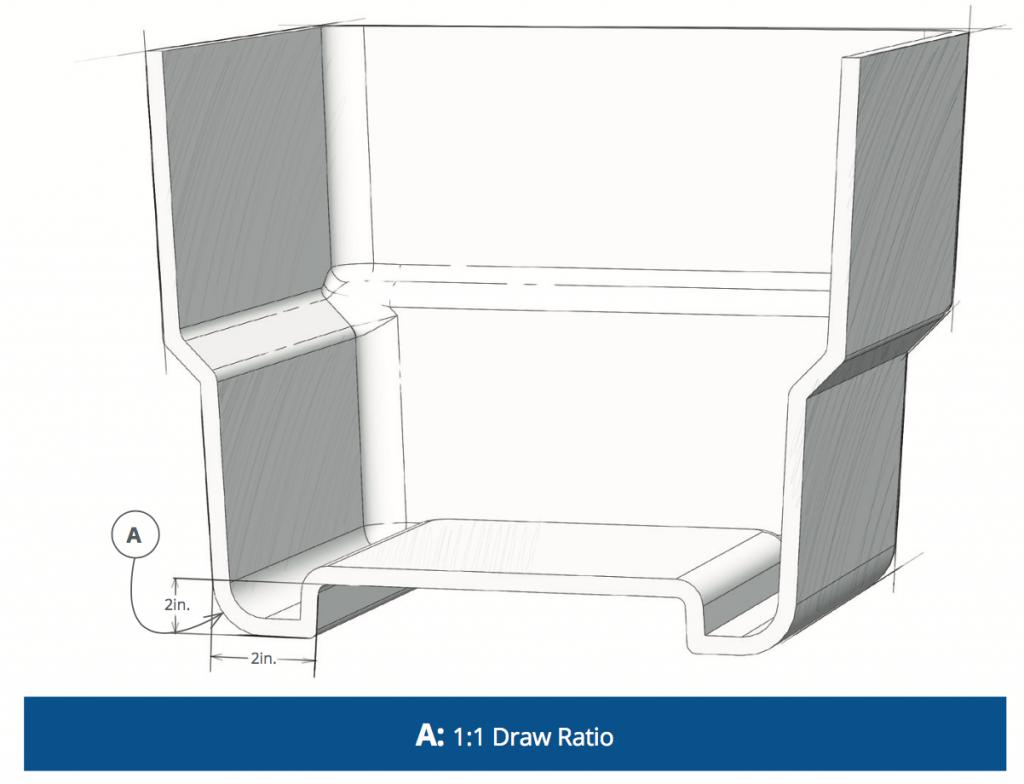The basic vacuum forming process is the foundation on which more flexible and elaborate thermoforming processes are built by adding elements such as billow and plug prestretching of the sheet. Read full chapter Request Thermoforming Design Guide Heavy Gauge Plastic Pressure and Vacuum Thermoforming Process and Design Guide. Productive Plastics is proud to offer for download its Heavy Gauge Plastic Thermoforming Process and Design Guide for Pressure and Vacuum Forming Applications. 1 1 Thermoforming Process (Vacuum Forming Process) 2 Manufacture Unit Manufacturing Processes Unit Manufacturing Processes Assembly and Joining Assembly and Thermoforming Inc. Vacuum and pressure thermoforming for the purpose of this discussion is to be consid General guidelines for part design are as follows, things that can be done with twinsheet that cant be done in the traditional singlesheet process. This guide was created by Productive Plastics Inc, drawing from over 55 years of heavy gauge thermoforming, manufacturing, and industry experience to Heavy Gauge Plastic Pressure and Vacuum Thermoforming Process and Design Guide. 3 What is Heavy Gauge Plastic Thermoforming. Vacuum Forming Guide 9 P a g e VACUUM FORMER SETTINGS On the touch screen you will see the following display. This is where you HAND mode offers you greater control over your vacuum forming process. Note: This mode also requires closer attention. All thermoforming techniques are stretching processes. The stretching of a flat sheet of plastic material into a larger shape results in a larger surface area and a corresponding reduction in the CAD CAM optimisation delivers efficiency and quality in the manufacturing of highquality plastic parts Wednesday 11th October 2017 Bridgewood UK are experts in the design, development and manufacture of innovative thermoformed plastic components and parts. The thermoforming cognoscenti among you know that this series has focused on some of the general concepts in thermoforming. We began with brief descriptions of polymers, then discussed heat transfer, mold materials, heaters, oven design. First, a sheet of thermoplastic is heated until it becomes pliable and moldable. In the vacuum forming process, the plastic is stretched over a single male mold, and air is vacuumed out from underneath the mold. Thermoforming Design Guidelines Universal Plastics 3 thermoforming is a process that uses heat and pressure to mold a flat sheet of thermoplastic Thermoforming Simple Solutions for Complex Problems using Plastic Thermoforming, Vacuum forming, Twin Sheet thermoform, and Pressure Forming plastics. Our unique services include InHouse Extrusion, Assembly, Painting, and finishing capabilities. Thermoforming Design Guidelines It is very important to realize that the key to cost effective production is to stay within the established processing limits specific to a part and to loosen these limits whenever possible. Thermoforming molds can be created from a variety of materials. Choosing the material is based on the dimensions of the part, polymer selection, features, accuracy and quantity. information on the thermoforming process, various forming methods, sheet quality, equipment, drying and heating, mold design, and part design. Though thermoforming represents just one of many options for shaping plastics into finished parts, the tremendous Thermoforming is a process that uses heat and Proper design will account for these characteristics. Some of the most common are: Vacuum Forming: This is the most basic process. In vacuum forming, vacuum alone is used to mold the part. The forming pressure is thereby limited to atmospheric pressure, about 14. Design, tooling and parts are fast and inexpensive compared to most other processes. Available Materials Stocking a wide range of materials like PETG, ABS, Styrene and much more in thicknesses ranging from 0. ) Real thermoplastics are strong, durable and inexpensive compared to 3D printed materials. Thermoforming is one of the oldest and most common methods of processing plastic materials. Vacuum formed products are all around us and play a major part in our daily lives. The process involves heating a plastic sheet until soft and then draping it over a mould. A vacuum is applied sucking the sheet into the mould. The sheet is then ejected from the mould. Thermoforming is a plastic fabricating process which involves heating sheet plastic and forming it over a male or female mold. The two basic types of thermoforming processes vacuum forming and pressure forming and derivative processes, such as twin sheet thermoforming, make plastic thermoforming a broad and diverse plastic forming process. THERMOFORMING DESIGN GUIDELINES. Srilatha Thermo Forming Processes Vacuum andor pressure formings primary advantage over other plastics processing techniques has always been its ability to produce threedimensional parts with a relatively low initial investment in time and cost for the molds in comparison with other processes. Vacuum Thermoforming Process Design Guidelines Vacuum Thermoforming Process Design Guidelines 1) A male or female mold and the hot sheet are moved into contact and a vacuum is Aluminum Tooling: For molded in dimensions of parts from a machined aluminum male mold. Design Rules for Vacuum Forming Molds. Vacuum forming for the purpose of this discussion is to be considered a single sheet of heavy gauge (. 060 thickness) thermoplastic, which is held in a rectangular or square platen, heated in a oven to an optimum forming temperature, then formed over a single sided tool. Formech International Ltd A VacuumA VacuumA VacuumA Vacuum Forming Guide Forming Guide Forming Guide Unit 4, Thrales End Lane, Harpenden, Hertfordshire, AL5 3NS, Tel 44 (0)1582, Fax 44 (0)1582. Thermoforming is the process of heating plastic sheets to a pliable temperature and forming them over tooling to create a usable shape. Gemstar employs three thermoforming processes: vacuum forming, snapback billow forming, and pressure forming. Design guidelines for vacuum forming plastic parts Monday 7th December 2015 The costeffective nature of vacuum forming (thermoforming) is what makes this process the production method of choice for many plastics component manufacturers. 0 Down votes, mark as not useful. Vacuum Thermoforming Process Design Guidelines. Uploaded by Rami Naama CW Thomas specializes in heavy gauge, large part thermoforming of plastics using both pressure and vacuum forming techniques. Every detail of the thermoforming process. Thermoforming is a very capable process, and the more you understand about its technical aspects, the more flexibility youll have in design. Draw Ratios A draw ratio is the calculation that lets you know what gauge of plastic you need to start with for any given thermoformed part. Thermoforming Mold Construction Guidelines METAPOR Thermoforming Moulds Like conventional tools, METAPOR molds are firmly mounted on the vacuum table. In order to After the cutting process, the air permeability of the slab surface is reduced due to partial closure of the pores. Vacuum Forming A vacuum is applied, the sheet is drawn into tight contact with the mold and the mold detail is picked up. Plug Assist Where a deep draw is required, a top plug may be used to push material into the mold during the vacuum forming process retaining even wall thickness. Manufacturers, suppliers and exporters based in India adhere to the industry guidelines while fabricating thermoforming machines. Types of Thermoforming Process: Vacuum Forming In this process a vacuum is formed between the mold cavity and the thermoplastic sheet. Thermoforming is a process of heating thermoplastic sheet and placing it over a mold until cooled. The thickness of the material determines whether the manufacturing process uses rolled sheets (thin gauge) or precut stacked sheets (heavy gauge). VACUUM FORMING (Male and Cavity Moulds) is the most basic of the thermoforming processes. The advantages over other plastic processes are the relatively low tooling cost and short leadtimes required to produce large, thick walled mouldings. Thermoforming is a manufacturing process for thermoplastic sheet or film. Specifically, it is more of a converting process, where plastic sheet or film is converted into a formed, finished part. The sheet or film is heated in an oven to its forming temperature, then stretched into or onto a mold and cooled. Thermoforming has close similarities with Vacuum Forming except that greater use is made of air pressure and plug assisted forming of the softened sheet. The process is invariably automated and faster cycle times are achieved than in the Vacuum Forming process. Only thermoplastics sheet can be processed by this method. Introduction to Thermoforming and Vacuum Forming. Thermoforming, vacuum forming and pressure forming are considered thermoforming processes. through the design process to make sure the final vacuumformed part is the right part for your project. Plastics Design Manufacturing has an extensive line of thermoforming equipment to provide the highest accuracy, process control, and capacity in the western region. Repeatability is a standard for long or short runs through computer controlled thermoforming equipment. Vacuum forming or thermoforming is forming a product by heating a plastic sheet. The sheet, a socalled thermoplastic wich is used for the thermoforming or vacuum forming is clamped in a stretcher. Thermoforming Design Guidelines May 14, 2015 By admin Vacuum and pressure thermoforming for the purpose of this discussion is to be considered a single sheet of heavy gauge (. 060 thickness) thermoplastic, which is held in a rectangular or square platen, heated in a oven to an optimum forming temperature, then formed over a single. Multifab Thermoforming Guidelines, Rev 6 4 09 1. MULTIFAB INCORPORATED 3808 North Sullivan Road, Building 6 Spokane, Washington, THERMOFORMING DESIGN GUIDELINES (Revision ) Multifab Inc. is an industry leader in the field of vacuum and pressure formed plastics for the Aerospace, Medical and other commercial. General: Thermoforming is a method of manufacturing plastic parts by preheating a flat sheet of plastic, then bringing it into contact with a mold whose shape it takes. This can be done by vacuum, pressure, andor direct mechanical force. The process offers close tolerances, tight. Thermoforming Design Guidelines By Thermoforming is a process that uses heat and pressure to mold a flat sheet of thermoplastic material to a particular shape. Vacuum Forming: This is the most basic process. In vacuum forming, vacuum alone is used to. Thermoforming tool design guidelines: Published: 15: 26: 51: Modern developments in tooling, thermoforming machines and techniques, together with improved thermoformable polymers, have made thermoforming one of the most rapidly growing polymer processing areas. vacuum thermoforming process design guidelines vacuum thermoforming process design guidelines 1) materials: generally speaking amorphous materials like polystyrene, abs, polycarbonate, pvc, and pvcacrylic blends are easier to vacuum form. pti will default to abs unless VACUUM FORMING: The process of evacuating air from the sealed space between the hot sheet and the mold, thus allowing atmospheric pressure (14. ) to force the GUIDELINES: The deeper or taller the part the heavier the starting gauge of sheet required. The key to good part design in thermoforming is understanding the need for a. Our Thermoforming Design Guidelines will teach you the essential rules for Drafting, Radii, Drawing Ratios, Under Cuts, Reference Points, Ribs and Bosses, Textures, Joining Lines, Trims, Holes, Cutouts and Vents, Hardware, Structural Parts and Tolerances. Design guidelines for the thermoforming process 1 1 Design guidelines for product engineers construction of moulds for the thermoforming process. It does not consider design issues such as draft angles, corner radii and draw ratios because these should have.











